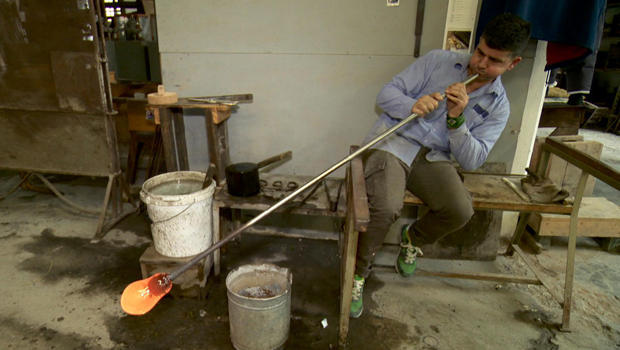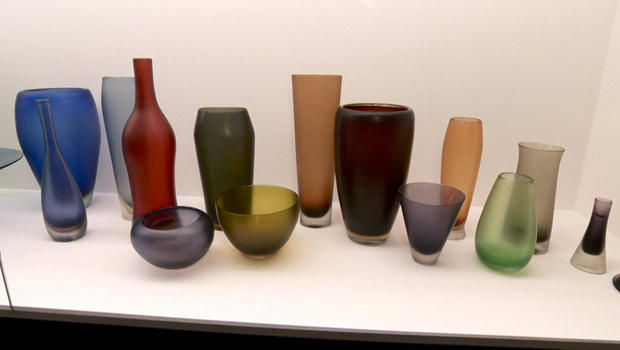Murano, a Mecca of glass
Seth Doane has found a true GLASS ACT, just across the water from Venice:
The furnaces glow orange and belch heat. And at around 3,000 degrees, something almost magical takes place: a sand mixture melts and becomes glass.
The molten concoction can then, like candy, be squeezed, pulled or shaped. It's a craft they've been perfecting on this Italian island for generations.
In this "glass Mecca," there's no mistaking the dominant industry, in store windows or street sculptures.
Adriano Berengo, who owns a studio here, said, "Somebody speak about the 'secret' of Murano, but to tell you, frankly, there are no secrets anymore. Glass is a chemical compound, so from the point of view of the material itself, there is nothing special about Murano. What is special is still the ability of the craftsman."
That ability is also on display at the nearby fornaco, or furnace, of the great glassmaker Archimede Seguso. Few words are said; the glass speaks in how it moves and hardens. It's a silent symphony. In fact, the lead glass blower is called maestro.
The finished product commands a high price. One piece retails for more than a thousand dollars.
Gino Seguso's father was a master. "Oh yes, a master of the masters!" he said.
Upstairs from the workshop, Gino showed Doane some of his late father Archimede's work, many of which have been featured in museums around the world.
Murano has set the trend for centuries, and the Seguso family has had some practice. They've been at it for 650 years -- that's 25 generations.
So how did Murano become this island of glass?
"Murano was an industrial settlement," Seguso explained. The city of Venice was mostly made from wood, and Venetian glass factories regularly caught fire, he said. So, by order of the doge, or ruler of the time, glassmakers were moved to the island of Murano in 1291.
Venice's lagoon functions as a moat, keeping Murano a fire-safe distance from the ancient city.
Putting so many glassmakers on such a small (less than a mile wide) island sparked competition, and created, in David Landau's eyes, something exquisite: "Murano glass can be different and can be stupendous. It can be marvelous and it can be nothing. Can be boring. Can be disgusting. Can be vulgar. But can be exciting. Can be extraordinary."
Landau, a successful entrepreneur and art historian, fell in love with glass. He now owns 2,500 pieces of glass. "It's madness, it's total madness," he laughed.
Objects of his infatuation are on display at Le Stanze del Vetro in Venice, which Landau co-created. It's part museum/part institute, and showcases the richness of Murano, and artisans like Italian Paolo Venini, and American Ken Scott's fish sculptures. "There is always a touch of something that makes the fish special," said Landau.
He notes this art form is struggling today due to cheap knock-offs from China, and fewer young people learning the craft.
- Ancient Italian craft may be a dying art ("CBS Evening News," 12/28/06)
Doane asked, "Glass has been made in Venice for 1,000 years. Does it have another 1,000 still to go?"
"Only? I hope more!" laughed Landau. "It's only a question of creativity, and that is what will always save Murano: Creativity, the challenge to do new things, the challenge to continue to have jobs."
Adriano Berengo shuns the world of old-school chandeliers and glassware, preferring to work with contemporary artists. He wanted to show Doane the old workshop he has transformed into what'll be a museum of contemporary art in glass.
He showcases the avant-garde, such as a chandelier made from broken champagne bottles.
"A traditionalist could say what you're doing here, contemporary art, threatens this great tradition of Murano glass," said Doane.
"Well, somebody might think so," replied Berengo. "But in reality I'm not threatening anybody; I'm advancing. I'm trying to bring glass to another step."
Glassmaking techniques were once a state secret in Venice. And while today the process may be common knowledge, the craftsmanship and know-how of this place sets Murano an island apart.
For more info:
- seguso.com
- Le Stanze Del Vetro, Venice (English)
- Berengo Studio, Murano
- Berengo Foundation
- muranonet.com
- muranoglass.com







